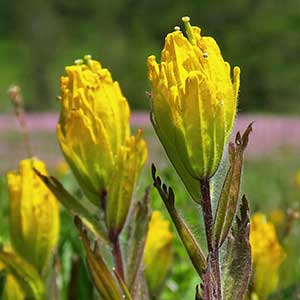Castilleja rupicola
Castilleja levisecta
cliff Indian paintbrush, cliff paintbrush
golden Indian paintbrush, golden paintbrush
many, decumbent to ascending, unbranched, sparsely pubescent, hairs spreading, wavy, fairly short, soft, eglandular, sometimes glabrous proximally.
few to many, erect, ± decumbent or creeping at base, unbranched, sometimes branched, hairs spreading, medium length and long, soft, mixed with short stipitate-glandular ones.
purple to green, narrowly, rarely broadly, lanceolate, 1.4–4 cm, not fleshy, margins plane, flat to involute, (0–)3–5(–7)-lobed, apex acute to acuminate;
lobes divergent, spreading-ascending, linear, long, not much narrower than mid blade, often with secondary lobes, creating little frilly fans, apex acute or obtuse.
green to purple or brown-tinged, linear-lanceolate proximally, oblong-ovate or -obovate distally, 0.8–5.2 cm, not fleshy, margins plane, distalmost sometimes ± wavy, involute, 3–7(–11)-lobed, apex obtuse;
lobes erect to ascending, linear to linear-spatulate, very short, toothlike, usually arising from distal 1/3 of blade, apex rounded.
2–6 × 2–3.5 cm;
bracts proximally greenish or deep purple near base, distally red, scarlet, or crimson to red-orange, rarely orange, salmon, pink, or yellowish white, ovate to orbicular in outline, 5(–9)-lobed;
lobes spreading, linear to linear-lanceolate, long, arising below mid length, apex acute to rounded.
2.5–25 × 1–4 cm;
bracts bright yellow throughout, or proximally greenish, distally bright yellow, sometimes deep yellow-orange, especially with age, oblong, elliptic, or obtuse to ovate, (0–)5–9(–13)-lobed, sometimes wavy-margined;
lobes erect to ascending, oblong, short to medium length, arising above mid length, central lobe apex rounded, lateral ones rounded to acute.
straight or slightly curved, 25–35(–45) mm;
tube 9–15 mm;
beak exserted, adaxially green, purplish, or yellow-green, 14–22 mm;
abaxial lip deep green, reduced, 0.5–2 mm, 6–12% as long as beak;
teeth incurved to erect, green, 0.5 mm.
straight or slightly curved, 17–28 mm;
tube 12–15 mm;
beak exserted, adaxially green or greenish yellow, 6–8 mm;
abaxial lip yellow or greenish, reduced, not inflated, 2–3 mm, 25–33(–50)% as long as beak;
teeth ascending to erect, yellow, 0.5–1.5 mm.
proximally purple, green, or whitish, distally colored as bract lobes, 15–25 mm;
abaxial and adaxial clefts 8 mm, ca. 40–50% of calyx length, deeper than laterals, lateral 1–5 mm, 10–20% of calyx length;
lobes triangular, apex obtuse or acute.
distally yellow, 13–22 mm;
abaxial and adaxial clefts 4–9.5 mm, 30–40% of calyx length, deeper than laterals, lateral 2.5–4.5 mm, ca. 25% of calyx length;
lobes linear to narrowly oblong or narrowly lanceolate, apex obtuse, sometimes rounded to acute.
= 24.
Castilleja rupicola
Castilleja levisecta
Castilleja rupicola is usually found in the subalpine and lower alpine zones in the Cascade Range from extreme southern British Columbia south to northern Douglas County, Oregon. Though it can be numerous where it occurs, the species as a whole is uncommon. One atypical population occurs in a moist, shaded, mossy, north-facing ravine on the Oregon side of the Columbia River Gorge, at less than 250 m. These plants often bear secondary divisions on deeply dissected leaves and bracts.
(Discussion copyrighted by Flora of North America; reprinted with permission.)
Castilleja levisecta is listed as threatened in the United States and endangered in Canada, where it is extremely rare. Most of its grassland habitat has been altered by development in the Puget Trough, and there are historical stations in the metro areas of what are now Victoria, Portland, and Seattle. For several decades, C. levisecta was considered extirpated from Oregon. However, recent reintroduction programs in Oregon and Washington have been very successful at reestablishing this species at several sites in the Willamette Valley. The bright yellow inflorescences often gradually age to a golden yellow color, unique in the genus.
Castilleja levisecta is in the Center for Plant Conservation’s National Collection of Endangered Plants.
(Discussion copyrighted by Flora of North America; reprinted with permission.)



